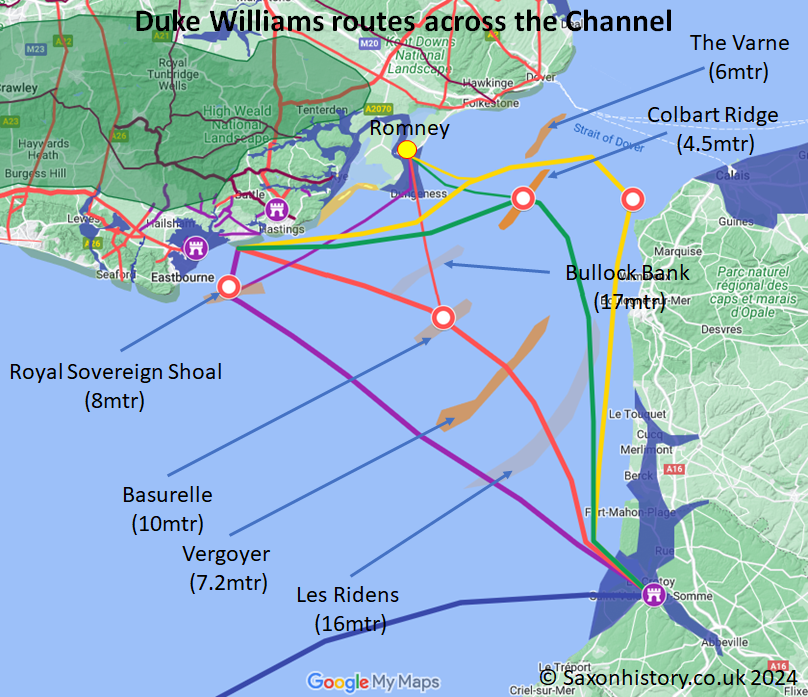|
 | Anglo Saxon History |  | |
| | Battle of Hastings 1066AD - G - New Romney Destroyed |
|---|
| | Documentary evidence |
|---|
Master Wace
The Duke placed a guard in Hastings, from the best of his knights, so as to garrison the castle well, and went thence
to Romenel, to destroy it utterly, because some of his people had arrived there , I know not by what accident, and the
false and traitorous had killed them by felony. On that account he was very wroth against them and grievously punished
them for it.
Orderic Vitalis
When his own dead had been given honorable burial he advanced to Romney, defeated the garrison and avenged the
slaughter of some of his men. They had landed there in error and had been routed in the ensuing battle by the fierce
defenders, with terrible losses on both sides.
| 
| | |
|---|
| What we know of the area |
|---|
The name Romney is derived from the Saxon 'rom' meaning a ram and 'ney' derived from 'en æg' - en -
people of and æg - an island - so 'the island of the ram people'.
The first written reference to Romney is dated 740AD in a grant of King Ethelbert which mentions the chapel of St.
Martin being located here. Sometime before this the Rother/Limen changed its course from where it originally reached the
sea at Hythe and broke through to the sea at ‘Old’ Romney.
Anglo Saxon Chronicle mentions
A.D. 893.
This year went the large army, that we before spoke about, back from the eastern district westward to Bologne; and
there were shipped; so that they transported themselves over at one time with their horses withal. And they came up with
two hundred and fifty ships into the mouth of the Limne, which is in East-Kent, at the east end of the vast wood that we
call Andred. On this river they towed up their ships as far as the weald, four miles from the mouth outwards; and there
destroyed a fort within the fen, whereon sat a few churls, and which was hastily wrought.
A.D. 894.
Hasten was there with his gang, who before were stationed at Milton, and also the main army had come thither, that
sat before in the mouth of the Limne at Appledore.
Post 900AD New Romney and the Langport
The Vikings had left but the slow moving Rother continued silting up the area around Old Romney, and the port had to be
moved to modern New Romney in the late 900's AD, where it was known as Langport.
The Domesday Book
only shows one entry for Romney with a tiny population and no damage, there is no mention of Langport, however the
Normans created the Rape of Langport, and not the Rape of Romney. This means its likely that the Chroniclers were
referring to the 'area of Romney' when they mention Romenel and not the settlement. This in turn means that the Langport
was the place that was destroyed and not Old Romney.
| | An Interpretation of the Chronicles |
|---|
Some of the Norman vessels landed on the Romney marsh probably near to Langport, the only logical explanation is that
these vessels were overloaded, or were taking on water and the nearest land was the Romney area.
The locals wouldn't have taken kindly to this as they had been supporters of Earl Godwin in the early 1050's, unlike
nearby Hastings who seemed to support the King and his Norman influence.
A thought:
If Fecamp controlled Winchelsea further along the coast it is possible that William had said that ships having issues
should land there, but some by mistake landed at the wrong port.
| | Archaelogy |
|---|
Evidence of Fire: Excavations in New Romney—including those conducted by the Kent Archaeological Society in the
1960s and 70s—uncovered layers of destruction from the late 11th century, including charred timber and ash.
Possible Causes: This fire might be linked to William the Conqueror's punitive campaign, such as the destruction of
Langport. However, accidental causes cannot be ruled out. Given that buildings in New Romney were primarily
timber-framed and sealed with flammable tar or resin (a common waterproofing method against Channel storms), the town
would have been highly vulnerable to fire. Combined with the area’s typically strong winds, even a small blaze could
have spread rapidly—whether by accident or design.
| | Conclusion |
|---|
It seems unlikely they would have landed in Romney by error as 700 ships were sailing together, it is
much more likely that the vessels were taking on water and they needed to reach the nearest shore, and if the route went
from the Colbart Ridge to Pevensey, then Romney would have been the nearest shore line.
Please look at our 'An analysis of Duke Williams forces'
page for a possible explanation of why ships may have been overloaded.
|
|
|
|
|
|
| |
|
|
Local Interest
Just click an image |
|
|
|
|
|
|
|
|
|
|
|
|
| |
|
|